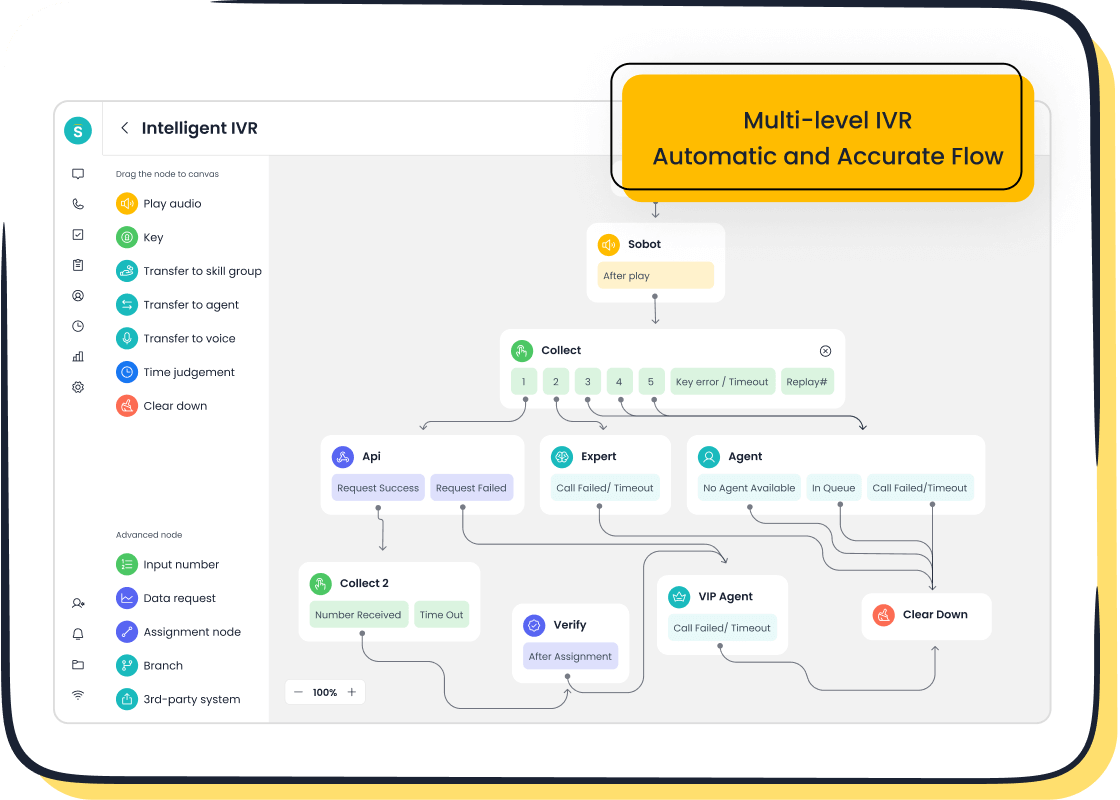Speak Like a Pro in Customer Care

Imagine navigating a customer care conversation where you feel confident, clear, and professional. That’s the power of mastering English in customer service. Strong English skills don’t just enhance your ability to handle customer queries—they open doors to career growth. Did you know that 68% of customers switch to competitors due to poor communication? Recruiters worldwide also value English fluency, with 70% considering it essential for roles in global companies. Whether you're explaining solutions or resolving issues, excellent communication skills ensure successful customer service conversations. Tools like Sobot can help you practice and improve every step of the way.
The Importance of English in Customer Care Conversations
Why English Fluency is Key to Excellent Communication Skills
English is the global language of business, and its role in customer service conversations cannot be overstated. When you communicate fluently in English, you can handle customer queries with clarity and professionalism. This fluency helps you bridge communication gaps, ensuring that your message is understood the first time. It also enhances interpersonal skills, allowing you to connect with customers on a deeper level.

In customer care conversations, excellent communication skills are essential for building trust. For example, when a customer calls with a complex issue, your ability to explain solutions in clear English can make all the difference. Tools like Sobot's Voice/Call Center can help you practice these scenarios, offering features like intelligent IVR and AI-powered voicebots to simulate real-life interactions. These tools breed confidence and prepare you for successful customer service conversations.
Common Challenges in Customer Service Conversations for Non-Native Speakers
Non-native English speakers often face unique challenges in customer service. The complexity of the English language—its grammar, idioms, and pronunciation—can make conversations daunting. Customers also tend to prefer native language communication, especially during phone interactions. According to research, 76% of customers prefer information in their native language, which highlights the difficulty non-native speakers may encounter.
However, there’s a silver lining. Many customers are more open to English communication in written formats like email or chat. This gives you time to process and respond thoughtfully. Leveraging tools like Sobot's Omnichannel Solution can simplify this process. Its unified workspace and multilingual support allow you to manage customer interactions seamlessly, reducing stress and improving efficiency.
| Statistic/Insight | Description |
|---|---|
| 76% of customers prefer native language information | Highlights a challenge for non-native speakers in customer service. |
| Complexity of the English language | Difficult grammar, idioms, and pronunciation hinder non-native speakers. |
| Preference for native language agents in phone calls | Customers feel more comfortable speaking in their native language over the phone. |
| Openness to English in text or email | Written communication allows non-native speakers time to process and respond. |
Benefits of Mastering Business English Conversation Topics in Customer Care
Mastering business English conversation topics offers numerous benefits. First, it enhances your communication skills, helping you listen better and expand your vocabulary. Second, it fosters cultural sensitivity, which is invaluable in today’s global market. Third, it allows you to forge meaningful connections with customers by showcasing empathy and professionalism.
Using precise language in customer service conversations demonstrates competence and builds trust. For instance, when you use the right terms to explain a product feature, you avoid misunderstandings and improve the customer experience. This clarity not only boosts your confidence but also makes your communication more efficient.
Language training also supports personal development. It helps you understand the subtleties of English, enabling you to convey messages clearly and comprehend others more accurately. By mastering these skills, you can enhance interpersonal skills and create stronger customer relationships.
Tip: Practice business English conversation topics regularly to improve your confidence and efficiency. Tools like Sobot's AI-powered chatbots can simulate real-world scenarios, helping you refine your skills and prepare for real-life customer care conversations.
Practical Techniques for Successful Customer Service Conversations

Role-Playing Scenarios to Build Confidence
Role-playing is one of the most effective ways to prepare for customer service conversations. Imagine practicing a scenario where a customer is upset about a delayed delivery. You can rehearse how to empathize, apologize, and offer solutions—all in a safe environment. This technique helps you build confidence and enhances your interpersonal skills, making real-life interactions smoother.
Role-playing also accelerates your proficiency. It allows you to understand customer perspectives better and identify areas for improvement. For example, Sobot’s Voice/Call Center offers tools like intelligent IVR and AI-powered voicebots that simulate real-world customer care conversations. These features let you practice handling complex issues while improving efficiency and time-to-resolution.
| Benefit | Description |
|---|---|
| Builds confidence | Helps you handle a wide range of customer issues confidently. |
| Enhances skills | Improves communication and interpersonal abilities. |
| Safe environment | Provides a low-stakes setting to make mistakes and learn. |
| Accelerates proficiency | Reduces the time it takes to become proficient in customer care. |
| Understanding perspectives | Facilitates a better grasp of customer needs and expectations. |
| Improves efficiency | Enhances resolution time and overall effectiveness in real interactions. |
Tip: Role-play regularly with colleagues or tools like Sobot’s AI-powered solutions to breed confidence and refine your skills.
Using Scripts and Templates for Common Customer Interactions
Scripts and templates are lifesavers in customer service. They provide a structured way to handle common scenarios, ensuring you use key phrases during customer service conversations. For example, when a customer asks about a refund, a script can guide you to explain the process clearly and professionally.
Using customer service scripts doesn’t mean sounding robotic. Instead, they help you stay consistent while allowing room for personalization. You can adapt them to match the tone and needs of each customer. Sobot’s Omnichannel Solution offers customizable templates that integrate seamlessly across channels like email, chat, and social media. This ensures you deliver effective communication every time.
Here’s how scripts and templates can enhance your customer experience:
- Consistency: Ensures all customers receive accurate information.
- Efficiency: Speeds up responses, reducing wait times.
- Confidence: Gives you a framework to handle tricky situations.
- Professionalism: Helps you maintain excellent communication skills.
Note: Keep your scripts updated with business English conversation topics to stay relevant and professional.
Recording and Reviewing Conversations for Continuous Improvement
Recording and reviewing conversations is a game-changer for customer service development. When you listen to your past interactions, you gain valuable insights into what worked and what didn’t. This practice fosters self-awareness and helps you enhance interpersonal skills.
Companies that implement call recordings often see remarkable results. For instance, unWired Broadband’s sales reps increased monthly deals from 26 to 70 after reviewing their calls. Similarly, Great Day Improvements recorded sales calls and saw a $756 per rep average yield increase, translating to millions in additional revenue. These examples highlight how reviewing conversations can lead to significant improvement.
Here’s why recording and reviewing is essential:
- Saves time on training by eliminating the need for ride-alongs.
- Encourages self-evaluation, boosting engagement and confidence.
- Identifies areas for improvement, ensuring continuous development.
Sobot’s Voice/Call Center simplifies this process with features like call tracking and recording. You can analyze conversations to pinpoint strengths and weaknesses, making every interaction better than the last.
Tip: Schedule weekly review sessions to refine your skills and forge meaningful connections with customers.
Tools to Enhance Customer Service Conversations with Sobot
Leveraging Sobot's Voice/Call Center for Realistic Practice
If you want to feel more confident during customer care conversations, practicing with realistic tools is essential. Sobot's Voice/Call Center is a game-changer for honing your English skills in customer service. It offers features like intelligent IVR and AI-powered voicebots that simulate real-world interactions. These tools let you practice handling various scenarios, from resolving complaints to explaining product features, all in a controlled environment.
One standout feature is the call recording and tracking system. It allows you to review your conversations, identify areas for improvement, and track your progress over time. For example, if you struggle with pronunciation or tone, you can pinpoint those moments and work on them. This continuous feedback loop accelerates your development and builds your confidence.
The impact of using tools like Sobot is undeniable. Studies show that businesses leveraging such platforms see a 20% reduction in inbound discussion volume and a 96% increase in positive feedback. The chart below highlights additional benefits:

By practicing with Sobot's Voice/Call Center, you not only improve your English but also enhance your communication skills, making every customer interaction more effective.
AI-Powered Chatbots for Simulated Customer Interactions
AI-powered chatbots are revolutionizing customer service conversations. They provide a safe and efficient way to practice business English conversation topics while simulating real customer interactions. Sobot’s AI-powered chatbots, for instance, are designed to handle multilingual queries, making them perfect for non-native speakers looking to refine their skills.
These chatbots can simulate a variety of scenarios, from answering FAQs to resolving complex issues. This versatility helps you practice using professional language and develop empathy in your responses. Plus, the 24/7 availability means you can practice anytime, fitting seamlessly into your schedule.
The numbers speak for themselves:
- Approximately 80% of businesses now use chatbots.
- AI handles 85% of customer interactions globally.
- In 2023, 69% of consumers reported satisfaction with their last chatbot interaction.
By incorporating chatbots into your learning routine, you can improve your confidence and fluency in customer service conversations. Sobot’s chatbots even offer personalized feedback, helping you fine-tune your communication style and build stronger connections with customers.
Language Learning Apps for Business English Conversation Topics
Language learning apps are another fantastic tool for improving your English skills. These apps focus on business English conversation topics, helping you prepare for real-life customer service scenarios. Many apps now include AI-driven speech analysis, which provides real-time feedback on your pronunciation and fluency. This feature is invaluable for refining your speaking skills.
Scenario-based learning is another highlight. Apps simulate real-world business interactions, such as handling complaints or explaining policies, so you can practice in a practical context. Interactive simulations also engage you in daily tasks, promoting natural and fluent speech.
Here’s a quick look at how these apps support your development:
| Feature | Description |
|---|---|
| AI-Driven Speech Analysis | Provides real-time feedback on pronunciation and fluency, helping users refine their speaking skills. |
| Scenario-Based Learning | Simulates real-world business interactions, enhancing confidence in industry-specific language. |
| Interactive Simulations | Engages learners in practical tasks that promote natural and fluent speech through daily practice. |
Pairing these apps with tools like Sobot’s Omnichannel Solution can amplify your learning. While the apps help you master English, Sobot’s platform lets you apply those skills in real customer service conversations. This combination ensures continuous improvement and prepares you for success in your career.
Building Fluency and Confidence in Customer Care

Overcoming Fear of Mistakes in Customer Service Conversations
Making mistakes during customer service conversations can feel intimidating, but it’s a natural part of learning. Instead of fearing errors, try to see them as opportunities for growth. When you focus on improving rather than avoiding mistakes, you’ll build confidence and enhance your skills over time.
Here are some ways to overcome this fear:
- Visualize successful outcomes to replace negative thoughts with positive ones.
- Understand that trying and failing is better than not trying at all. Each mistake teaches you something valuable.
- Channel your desire to avoid errors into making better decisions during conversations.
Remember, even seasoned professionals make mistakes. What sets them apart is their ability to learn and adapt. By practicing regularly, you’ll breed confidence and feel more prepared for real-life customer care conversations.
Developing Active Listening and Empathy Skills
Active listening and empathy are essential for creating a great customer experience. When you truly listen to customers, you show them that their concerns matter. This builds trust and strengthens your connections with them.
Here’s how you can develop these skills:
- Practice active listening by repeating customer statements to confirm understanding.
- Participate in training sessions focused on empathy and effective communication.
- Use simulated customer interactions to practice problem-solving and empathetic responses.
- Set clear goals, like improving customer satisfaction scores, and track your progress through surveys.
Empathy bridges communication gaps and makes customers feel valued. When you combine this with active listening, you’ll enhance interpersonal skills and create meaningful connections that improve the overall customer experience.
Practicing Tone and Professional Language for Excellent Communication
Your tone and choice of words play a huge role in customer service conversations. Studies show that tone of voice contributes 38% to effective communication, while words account for 7%. This means how you say something often matters more than what you say.
To improve, focus on these areas:
- Use professional language to demonstrate competence and professionalism.
- Adjust your tone to match the customer’s mood—calm and reassuring for complaints, upbeat for positive interactions.
- Practice key phrases to use during customer service conversations, such as “I understand your concern” or “Let me assist you with that.”
By refining your tone and language, you’ll forge meaningful connections with customers and leave a lasting impression. Tools like customer service scripts can help you stay consistent while allowing room for personalization.
Tip: Record your conversations and review them to identify areas for improvement. This practice supports continuous development and helps you master the role of business English in customer care.
Applying Skills to Real-Life Customer Service Scenarios
Handling Complaints and Difficult Customers with Confidence
Dealing with complaints or difficult customers can feel overwhelming, but it’s also an opportunity to shine. When you handle these situations effectively, you not only resolve issues but also build loyalty. Research shows that customers whose complaints are resolved quickly are more likely to stay loyal and even recommend your brand. So, how can you approach these conversations with confidence?
Start by thanking the customer for their feedback. This simple gesture can shift their mindset from negative to positive. Then, focus on active listening. Let the customer explain their issue fully before you respond. Empathy is key here—acknowledge their frustration and show you care about resolving the problem. Proper training also plays a big role. It equips you to handle various scenarios, whether it’s a billing error or a delayed delivery.
"A study by Harvard Business Review found that customers who have a complaint handled in less than 5 minutes are willing to spend more on future purchases."
Here’s a quick checklist to guide you:
- Thank the customer for their feedback.
- Listen actively and acknowledge their concerns.
- Address the issue swiftly and professionally.
When you follow these steps, you’ll turn challenges into opportunities to strengthen customer relationships.
Providing Clear Explanations and Solutions in Customer Care Conversations
Clarity is everything in customer service conversations. Customers want solutions, but they also want to understand the "why" and "how." Providing clear explanations not only resolves issues but also builds trust. Studies show that customers prefer low-effort interactions, meaning they value straightforward and easy-to-follow communication.
To achieve this, focus on simplifying your language. Avoid jargon and stick to terms the customer will understand. For example, instead of saying, “The system encountered a technical anomaly,” you could say, “There was a technical issue, but we’ve fixed it.” Using tools like conversation analytics can also help. These tools analyze customer interactions to identify patterns and improve your responses.
| Evidence Description | Key Insight |
|---|---|
| Understanding customer sentiments through conversation analytics | Helps businesses build customer experiences that meet expectations. |
| Research shows customers prefer low-effort interactions | Indicates that clear explanations and solutions are essential for a positive customer experience. |
When you provide clear explanations, you make the customer feel valued and understood. This approach not only resolves the issue but also enhances their overall experience.
Maintaining Professionalism in High-Stress Situations
High-stress situations test your patience and professionalism. Whether it’s a system outage or an irate customer, staying calm and composed is crucial. Professionalism builds trust, and empathy strengthens connections with customers during challenging moments.
Stress can impact both agents and customers. If you lose focus, it can lead to inefficiency and lower satisfaction. However, maintaining professionalism and demonstrating competence can turn things around. For example, using a calm tone and reassuring language can de-escalate tense situations. Phrases like “I understand how frustrating this must be” show empathy and help diffuse anger.
| Effect of Stress on Agents | Impact on Customer Satisfaction |
|---|---|
| Decreased effectiveness | Lower customer satisfaction |
| Reduced professionalism | Negative service quality |
| Increased inefficiency | Poor customer experience |
By staying professional, you not only resolve the issue but also leave a lasting impression. Remember, every interaction is a chance to show your commitment to excellent service.
Mastering English for customer service conversations takes practice, but the rewards are worth it. By role-playing scenarios, using scripts, and reviewing your conversations, you can sharpen your skills and build confidence. These techniques help you connect with customers, show professionalism, and improve your communication. Remember, every conversation is a chance to grow and strengthen your connections. Keep practicing, stay consistent, and watch your career in customer care flourish.
Tip: Use tools like Sobot to make your practice sessions more effective and realistic.
FAQ
How can I improve my English for customer service conversations?
Start by practicing daily. Use tools like Sobot’s Voice/Call Center to simulate real-life scenarios. Role-play with colleagues or AI-powered chatbots to build confidence. Focus on active listening and tone. Apps for business English can also help you refine your vocabulary and pronunciation.
What’s the best way to handle complaints professionally?
Thank the customer for their feedback. Listen actively and acknowledge their concerns. Offer clear explanations and solutions. Use phrases like “I understand your frustration” to show empathy. Tools like Sobot’s Omnichannel Solution can streamline communication and help you respond effectively.
Are scripts helpful for customer service conversations?
Absolutely! Scripts provide structure and consistency. They help you stay professional and confident during tricky situations. Sobot’s customizable templates ensure you deliver accurate information across channels like email, chat, and social media. Just remember to personalize them for each customer.
How can I practice tone and professional language?
Record your conversations and review them. Pay attention to your tone and word choice. Use tools like Sobot’s Voice/Call Center to simulate interactions and refine your communication style. Practice phrases like “Let me assist you” to sound calm and professional.
What tools can help me improve my customer care skills?
Sobot offers powerful tools like AI-powered chatbots and a Voice/Call Center for realistic practice. Language learning apps can enhance your vocabulary and pronunciation. Combine these tools to master English and build confidence in customer service conversations.
See Also
Essential Strategies for Effective Call Center Quality Control
Transforming Customer Support with AI-Powered Service Agents
Comparative Analysis of Leading Voice of Customer Tools